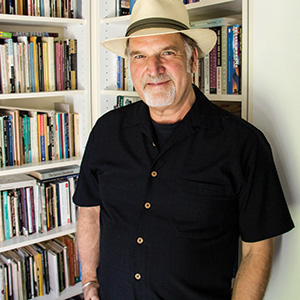For his new book of poetry, SJSU Professor Alan Soldofsky went to China and read the writing on the wall. Of a cave, that is. He spent time with monks who couldn’t find their cell phones, learned that most Chinese people currently grow up memorizing hundreds of Tang Dynasty poems hand also discovered the future largest Buddha statue in the world.
The statue wasn’t finished yet, but Soldofsky knew his experiences would seep into his book, aptly titled In the Buddha Factory.
The book unfolds in three sections, respectively titled, “Present,” “In the Buddha Factory,” and “Hyperreal.” The first section deals primarily with the South Bay and its environs. The title section comes next, influenced by Soldofsky’s trip to China. For the third section, Soldofsky placed famous poets in certain California towns. Poems in that section include “Coleridge in West Marin,” “Wordsworth in Santa Cruz” and “Virgil in Los Angeles.”
But China is what factored most prominently in Soldofsky’s consciousness. He walked in the footsteps of the ancient poet Han Shan, aka Cold Mountain, the heroic hermit Gray Snyder translated. Soldofsky also traveled to a monastery, virtually unchanged after a thousand years, where Han Shan’s own writings still graced the rocks.
Soldofsky has channeled that adventure into several poems including the title shot, which depicts factories churning out Buddha statuettes for tourists in Las Vegas. The world’s largest Buddha, in another case, was being built for a temple in Los Angeles. As with many creatively inspired travels, Soldofsky viewed the experience through a split lens, half of arrival and half of departure. Like any poet, he then juxtaposed those experiences with what already percolated in his unconscious and the muse pulled the trigger. In the poem, “At Yangdang Shan,” for instance, he writes:
For ten days I’ve been looking for my shadow./Lost amid the outlines of mountains./At last the sun is out, green halos shining on the spires of the peaks./It won’t last. These words, too, are only souvenirs.
Of course, trying to explain where the muse comes from can be complicated, especially to literal thinkers. Soldofsky’s approach is refreshingly unacademic. When I showed up in his office to inquire about such matters, he provided some words I wish I had said:
“What poetry is about, is how unexpected angles of perception compound and grow and build on another and continue to exfoliate,” he told me. “It’s being able to hold on to these moments of weirdness that are almost hallucinatory in their vividness. It’s like a dream in real life. And then the language reinforces that dreamlike quality. That’s what I’m trying to produce. Or reproduce. And define the ambiguity of the result, so that the world becomes much more malleable and less certain in being one way or another way, but is multiple ways at once.”
That’s exactly what I’ve tried to do in this space over the years, when exploring the San Jose condition. In my case, for “poetry” I would substitute “newspaper columns.” For Soldofsky, though, it isn’t even that complicated. We’re all in the same skin, as poetically creative types. Experiencing a poem can be like experiencing a film or any other art form. Multiple interpretations are encouraged.
“Poems are an experience on two levels,” he says. “They’re an experience of what you grasp from decoding the words. And they’re an experience of what happens to you when you say the words in your own head, or even say out loud. … It’s a way in which emotion, experience through our common language and perception all join.”
In the end, Soldofsky says poets are people who often utter things in a different tune and when poets get together, it’s usually nothing but a grand old time. Literal thinkers need not apply.
“We experience the world differently,” Soldofsky said. “And we don’t mind. It’s fun for us. It may not be fun for the people that have to spend time with us, but it’s fun for us.”
In the Buddha Factory
SEPT 30 7pm




